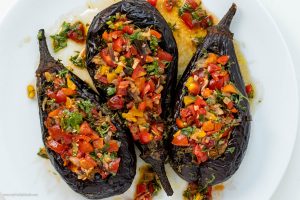A Word About Our Recipes
I have learned how to coax the maximum amount of flavor from food during my years as a professional chef. I’ve combined these fundamentals with new plant-based techniques and ingredients to create a style of food born from my obsession with taste. But, that is not my sole purpose in presenting my plant-based recipes on this site. I want my food to be based on my needs, preferences, and desires – and keep me happy, healthy, and vibrant! I also want to share what I have learned along the way – and what I continue to learn – to anyone who is embracing a plant-based diet in their life.
This site features modern plant-based recipes and encourages contemporary cooking techniques. I use ingredients that promote health and maximize flavor. Everything on this site is appropriate for the curious home cook, who is eager to discover a fascinating world of plant-based cooking. I try to focus on the use of whole foods and avoid using strange ingredients created in a chemical lab. I limit the use of oils in my recipes and avoid the use of tropical fats. Whenever I use oils, I attempt to preserve the integrity of the oil by utilizing cooking techniques that limit their exposure to high heat and oxygen for extended periods.
The recipes presented here are not focused on making anything too complicated or exotic – although I recognize those are relative terms, and that is why I’ve included an extensive and expanding section on techniques.
I know diet is a personal and subjective thing. Culture and memory influence people – as can the state of their own mind, body, and spirit. Some may find it challenging to embrace some ingredients I use, while others will eagerly embrace new ideas and ingredients. The detailed ingredients section on this site is designed to help clarify ingredients used in recipes and offer tips on how to prepare those ingredients.
On a more personal note, my dietary habits closely follow the dietary suggestions of the Overcoming Multiple Sclerosis protocol as outlined by Professor George Jelinek. The OMS diet limits saturated fat intake to less than 15 grams per day – ideally even less. This effectively eliminates all animal products from the diet (with the noted exception of fish consumption, which I have chosen to also eliminate). It also eliminates the use of all tropical fats (notably coconut and palm), which are high in saturated fats. The OMS diet does include oils, but cautions against using processed and hydrogenated (margarine) fats. Oils exposed to high heat during cooking should also be avoided. This rules out most forms of frying or deep-frying.
The OMS diet is based on rigorous scientific research, and this is the main reason I have chosen to follow the guidelines closely. The OMS diet, however, is not simply limited to those who have multiple sclerosis. It is quite like other extremely popular ‘health’ diets like the Ornish protocol to treat cardiovascular disease or the Forks Over Knives approach. These diets are clearly beneficial for people with a variety of chronic Western diseases (all degenerative and autoimmune diseases, heart disease, high blood pressure, type 2 diabetes, lupus, rheumatoid arthritis).
Ultimately, the recipes I’ve included on this site are designed for people who choose to avoid eating animal products, so it doesn’t matter if you are here for ethical or health reasons – the recipes will work for you in either case.
The recipes on this site reflect my fresh attitude toward cooking. You can be confident anything you choose to prepare from this site will bring you much pleasure…and quite possibly impress your meat-eating or vegetarian friends and family.
Finally, all our recipes are presented in metric form! I know this breaks with tradition and it is bound to cause some heartache with those who are not familiar with this measuring system. I apologize for the inconvenience, but I assure you – this will be a blessing in your future. My previous cooking experiences in the USA were always based on cups, teaspoons, gallons, pints, etc. This was something I was forced to change the first time I came to Europe to cook professionally. Everything I encountered was in a foreign language and foreign method of measuring – including oven temperatures. The first thing I learned in this alien environment was how to use a scale. As it turned out, this was incredibly simple and I didn’t understand how I could ever return to such a complicated (and inaccurate) method of measuring ingredients for a recipe. I also realized accurate measurements were crucial in writing out recipes to reproduce, scale to differing amounts, and share with others. So guess what? I changed and I think you can too! So, if you don’t have a scale…please go out and get one (it would be helpful if it measured in metric and imperial so you can convert your own recipes).
